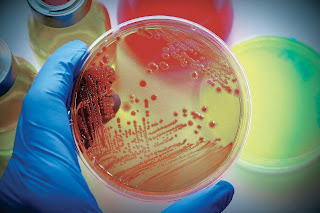The present investigation was undertaken to isolate and screen the cellulase producing bacteria from soil. Cellulose is considered to be the most abundant carbohydrate on earth along with hemicelluloses and lignin, which constitutes the plant cell wall. Cellulolytic enzymes are the backbone of various industries including food, animal feed, brewing, wine, agricultural biomass refining, pulp, paper, textile and ethanol production. In this paper, cellulose degrading bacteria was isolated and screened from different soil samples from agriculture farm, waste dumping area and termite soil using Carboxymethyl cellulose CMC , wheat bran and waste paper plus nutrient agar as a selective medium. After screening, only five isolates KHU2, KHU8, KHU9, KHU13 and KHU14 were selected due to the maximum diameter of zone of substrate hydrolysis. The diameter of zone of substrate hydrolysis in NAM plates containing wheat bran for the isolates KHU2, KHU8, KHU9, KHU13 and KHU14 was 8±3mm, 21±2mm, 13±1mm, 12±1mm and 10±2mm, respectively, whereas the diameter of zone of substrate hydrolysis in NAM plates containing waste paper for the isolates KHU2, KHU8, KHU9, KHU13 and KHU14 was 13±1mm, 24±1mm, 17±1mm, 14±2mm and 15±1mm respectively. This was compared with the diameter of zone of substrate hydrolysis in NAM plates containing CMC cellulose was also measured for the isolates KHU2, KHU8, KHU9, KHU13 and KHU14 was 16±1mm, 25±1mm, 22±1mm, 19±2mm and 20±2mm. It was concluded that the diameter of zone of substrate hydrolysis on waste paper was nearly same as obtained with CMC cellulose and the highest diameter of zone of substrate hydrolysis was seen in isolate KHU8 25±1mm in NAM plates plus CMC cellulose from termite soil sample. So, termite soil has the maximum potential to produce cellulose degrading bacteria.
By Khushboo Pal | Anshika Sharma | Tanu Sharma | Dr. Divya Sharma "Cost-effective Analysis of Different Soil Samples to Check their Potential for Producing Cellulose Degrading Bacteria" Published in International Journal of Trend in Scientific Research and Development (ijtsrd), ISSN: 2456-6470, Volume-5 | Issue-5 , August 2021,
URL: https://www.ijtsrd.com/papers/ijtsrd43937.pdf








No comments:
Post a Comment